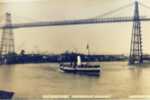
LINKS UNTEN
Website
über
die
Schwebefähre
von
Newport
Förderkreis der Newport Transporter Bridge
Archiv
des South Wales Argus
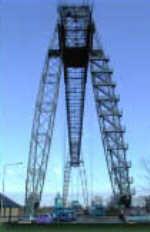
Fotoseite
![]()
City transporter bridge centenary
Newport's landmark transporter bridge across the
River Usk is celebrating its centenary.
The bridge, one of only eight in the world, was
opened on 12 September, 1906 by Viscount Tredegar.
It was built to cope with rapid development on the east side of the river and to take workers to the Lysaghts steelworks in particular.
Campaigners hope the Grade I-listed structure will eventually be made a world heritage site.
The anniversary is being celebrated with music and fireworks, and a special exhibition at Newport Museum and Art Gallery.
The occasion will also be marked with the opening of Newport's £5m foot and cycle bridge.
In February, Newport Council agreed to spend £180,000 on restoring the bridge, including major improvements to the motor house on the river's east bank.
Anne Gatehouse, from the Friends of Newport Transporter Bridge (FONTB), said: "The bridge came about because of a chap called John Lysaghts who wanted to build a steel works in Newport - which he did.
"Part of the bargain with the town council was that he asked for a bridge near to the area where most of his workers would be living."
She said the structure, one of the highest and longest transporter bridges in the world, was built to cope with the river's high tidal reach and so ships with tall masts could pass underneath.
"It's definitely iconic - it's the icon of Newport and of Wales really. The whole of the Welsh nation should be proud of it," she said.
"Let's hope it goes for another 100 years."
Richard Parnaby, professor of architecture at the University of the West of England, Bristol, said the bridge was an "eccentric and wonderful" structure.
"It's clearly a pretty daft idea - the capacity is obviously extremely limited - but it's beautifully daft and it's a great experience going across it," he added. "It's so nice to be able to travel on it."
"Würdig
wie Apollo,
stark
wie Herkules"
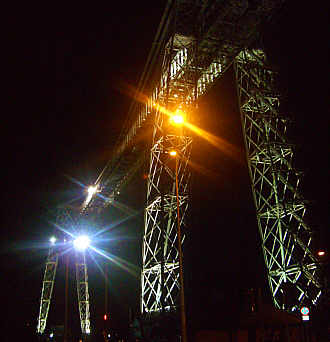
Rund 14 000 Menschen feierten im September 2006 mit einer Festwoche, deren Höhepunkt das "Crow Point Festival" (Website) war, das 100-jährige Bestehen der mustergültig restaurierten Schwebefähre über den River Usk.
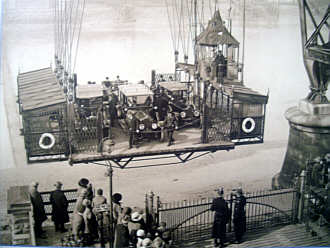
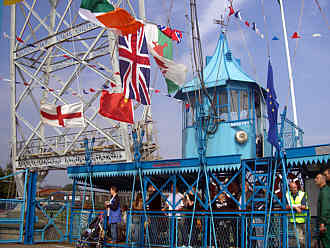
Fahnenschmuck zum 100. Geburtstag
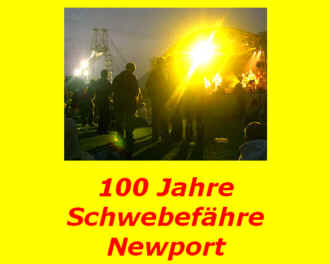
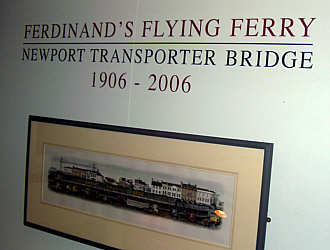
Ausstellung zum Jubiläum (Website)
Auch in Newport hatte der Franzose Ferdinand Arnodin, Weltmeister im Schwebefährenbau, das Problem zu lösen, die Mündung eines schiffbaren Flusses in einer dicht besiedelten Gegend zu überbrücken, in der sich der Bau langer Rampen von selbst verbot.
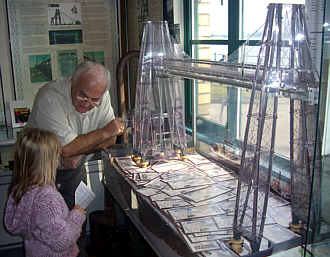
Das Besucherzentrum an der Schwebefähre
So bot sich auch hier das Prinzip der "transporter bridge" an. Die Schwebefähre, deren Gondel von zwei Elektromotoren betrieben wird und sechs Autos befördern kann, wurde 1906 in Betrieb genommen. "Würdig wie Apollo, stark wie Herkules", rühmten Zeitgenossen das Bauwerk.
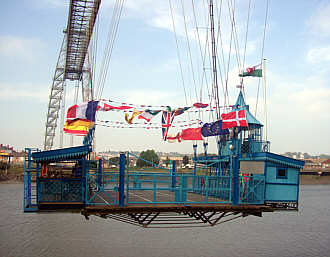
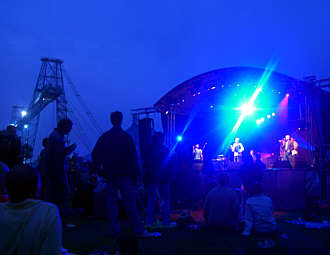
Crow Point Festival im September 2006
Die Schwebefähre steht einige Meilen südlich vom Zentrum Newports. Einen Lageplan gibt es hier. Eine äußerst sehenswerte Ton-Bild-Schau kann hier heruntergeladen werden.
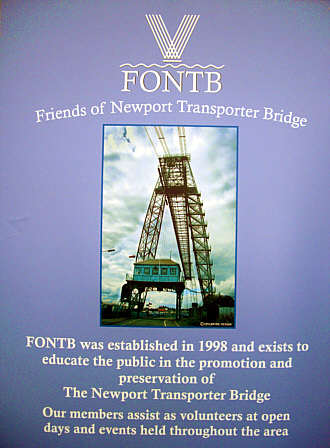
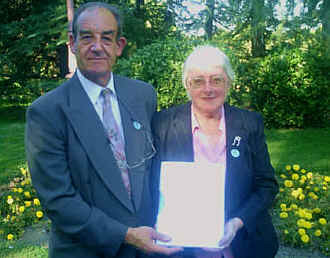
AN EXCITING
FUTURE FOR
THE TRANSPORTER
BRIDGES
Following less than a days notice the Chairman and Secretary of FONTB found themselves setting out on a trip to Spain on Wednesday afternoon, the 17th September, to attend the inaugural meeting of The World Association of Transporter Bridges in Madrid and Bilbao.
Alan and Anne attended as the representatives of both Newport City Council with the blessing of the leader of the Council, Sir Harry Jones, as well as FONTB. Invitations had been sent out from Bilbao to all the other seven existing transporter bridges inviting those responsible for their bridges to meet together in Madrid and then Bilbao to discuss the setting up of a new initiative as a �linking� organisation. Delegates included Mayors, engineers, elected councillors and Friends of the Bridge. A Spanish Bank and other local corporate sources met the cost of the flights, accommodation and hospitality.
It was mid afternoon on Thursday September 18th when we finally arrived at our destination to be warmly greeted by Rocio Velasco. At 3.00pm we sat down with the other bridge delegates around a very large lunch table in the magnificent surroundings of a golf and riding club, The Real Club de la Puerta de Heirro, located in the outskirts of Madrid. Twenty-four of us from Newport, Middlesbrough, Warrington, Rochefort, Osten, Rendsberg, Buenos Aires and Bilbao met together for the first time. Amongst the representatives there were four mayors. We all had one thing in common; we all represented an existing transporter bridge and the enthusiasm was very evident.
Once our hunger was appeased by an excellent meal and wine, the next formality was for Rocio, our charming and efficient event co-ordinator, to explain some protocol. We were to be presented to His Majesty, King Juan Carlos of Spain, who has graciously consented to be the President of this new organisation, The World Association of Transporter Bridges. We were told how to greet the King and the ladies were taken into the next room to practice their curtsy. Some of us will remember Rocio when she visited our Newport Bridge at the end of January this year.
A coach then conveyed us to the royal residence, the Zarzuela Palace set amidst acres of grounds, which for us had a feint resemblance to Richmond Park with many deer grazing close to the roadside. Security was very evident and most efficient. We entered the Royal residence and within a retiring room the four mayors donned their chains of office. Then we were conducted into a large room where we lined up ready to be received by His Majesty. When King Carlos entered he came along the line of representatives shaking our hands and greeting us all individually, a curtsy and a bow from Anne and Alan respectively. Presentations of pictures and other mementos were made to His Majesty from all the bridges represented and further informal discussion took place led by the King as he prompted us for our thoughts on the future of our bridges; he was very interested in all that we told him. We are now confident that we have a wonderful President for our new Association.
When the audience was over we returned in our coach to Madrid Airport where we had a short flight to Bilbao arriving at 10.30pm. Taxis were laid on to convey us for the 15-minute ride to our hotel, the Puente Colgante Hotel, which happened to be located immediately next to the Bilbao Transporter Bridge. The bridge is actually called the Vizcaya Bridge in the area known as Portugalete and is some 7 miles downstream of the centre of Bilbao.
The next morning after breakfast we received a conducted tour of their transporter bridge given by Vicky Buckton, a director of the company who run and operate the bridge. A lift conveyed us to the top of the bridge and your secretary Anne Gatehouse achieved another ambition by standing on top of a transporter bridge for the first time. Space precludes describing all the innovative improvements and facilities for both the tourist and the local community, which have now been provided there. Some extensive investment has taken place. It is a bridge, which operates 365 days of the year and 24 hours a day with a staff of 36!
Descending to the east bank we assembled in the hotel conference room for our main meeting, which was filmed and recorded and the proceedings were backed by simultaneous translation in English, French, German, and Spanish for all the delegates to fully understand what each representative around that table had to say. The initial formal document of the articles of Association of the World Transporter Bridge Association were read out and then discussed. Various points were raised before the selection of a committee was proposed and the officers were selected from the delegates present.
Your Chairman, Alan Cohen, is now the Honorary Treasurer of the new association, with the Secretary, another member of a Friends organisation, coming from Osten, in north Germany, the Vice Chairman from Buenos Aires, and the Chairman from Spain. We have an international representation on our first committee, which bodes well for all our futures.
A full press meeting then followed with many members of the media present including those from local and national newspapers and television companies. They asked a number of questions of the newly elected committee. We were then whisked off the short distance to the bridge again to meet more local dignitaries and important officials before being entertained to a short choral concert on the lower outdoor bridge platform over the souvenir shop and bridge offices. The Santa Maria Choir of the Village of Portugalete gave this. The standard of their singing was excellent and enjoyed by all of us as well as by many of the locals passing by, who stopped to listen. It must be mentioned that out in the sun the temperature was over 30 degrees and the choir had been waiting for us for over an hour. It was hot and we were running a little behind schedule, but there in Bilbao time seems to have little meaning.
A coach then took us to an exclusive Bilbao Golf Club, the Real Sociedad de Golf de Neguri, for lunch where we met the British Consul for Bilbao and several more of the many important local people deeply interested in the reasons for why we were meeting together. More presentations and speeches followed a magnificent lunch. They tend to eat later in Spain than we do here so lunch was taken at 3.30pm and it was past 5.00pm before we boarded our coach to visit the Guggenheim Museum in central Bilbao.
At 7.00pm we had completed a short guided tour of this remarkable museum, remarkable for both its architecture and the contents and we took a leisurely stroll down the street within the local shopping until we reached a central square, the Plaza de Federica Mayua, passing an Irish pub on one of the corners called �The Dubliners�. We had two hours to ourselves to shop or browse the stores and watch the world pass by. Anne and I just sat under an awning, where a restaurant had tables and chairs set out in the middle of a street shopping precinct to rest and recover our breath over a cool refreshing drink. It did not take us too long to start networking for FONTB with two Canadian ladies sitting close by, who have continued their walking holiday each clutching a copy of our new leaflet. Perhaps a new member will result from Canada?
At 9.00pm we returned to our coach and after a very short drive reached the destination for our dinner that evening. This was in an exclusive Gentleman�s Social Club, the Sociedad Bilbaina. Over aperitifs the President of the Club, who showed us their unique collection of art, gave us a conducted tour. Then there followed a most unusual event. For the first time in the club�s long history, the five ladies in our party, plus Rocio and the other ladies, wives of the local delegates, were honoured by being the first ladies ever admitted to the club�s reading room and library in the entire club�s history! It must be something about transporter bridges that has such an effect and opens doors.
Our host the Club President provided us with a wonderful meal and we toasted the successful future of all our bridges in champagne. By the time we left the club it was past midnight and our coach drove us back to our hotel arriving on the opposite bank of the River Bilbao and then, to our surprise, drove onto the bridge gondola. Sitting up in the front of coach with the gondola gates out of site beneath the dashboard gave us a sensation that was quite unreal. All we could see was the water in front of us. It was 1am in the morning and Portugalete in Bilbao was still very much alive.
Saturday morning dawned. Again it was a sunny day,
which turned warmer and warmer as it had done since we had arrived. I think
it was about 4.00am that the local market started setting up in the small
square just outside our hotel window. Our taxi arrived at 8.30 to take
us to the airport. The ride was exhilarating and hair raising to say the
least; so much for Spanish taxi drivers, but we got to the airport safely.
A flight to Madrid and then a wait to change flights for our plane back
to London Heathrow. We arrived back in Newport at 6pm both exhausted but
still excited from our wonderful experiences of the past few days. All
the transporter bridges now face a new future.
![]()
A triumph of Victorian engineering, the bridge
was designed by Ferdinand Arnodin and opened in 1906. It is believed to
be one of only five remaining similar bridges in the world. This aerial
ferry allowed people to cross the river without obstructing shipping. The
bridge has been completely restored, and has won the Europa Nostra Heritage
Award.
![]()
Structural defects led to the bridge being closed
to traffic in 1985, but ten years later it was back in use. Between 1992
and 1995, a £1.3 million ERDF grant helped fund a £3 million
refurbishment of the bridge itself, and a second phase of development work
provided floodlighting and a viewing area. In 1997, the project received
a Europa Nostra Diploma in recognition of the high quality of the restoration
work. The tourist potential of the Transporter Bridge is being developed
in a fourth phase of work: redeveloping former office accommodation to
provide a visitor interpretation facility, aimed at increasing the tourist
potential of the bridge. The facility also provides appropriate educational
displays and exhibition material and improved access for disabled visitors.
Konver has contributed nearly £62,000 towards a total cost of £130,000
for this fourth phase.
![]()
En 1906 se inaugura en la localidad Británica
de Newport el primer puente transbordador de ese país. Construido
en esta ocasión tambien por Ferdinand Amodin, unia una distancia
de 197 metros. El travesano se encontraba a 54 metros sobre la pleamar,
midiendo las columnas 74 metros de altura. El coste de la estructura de
acero, asi como de los aparatos de transporte alcanzó las 35.000
libras. Desde su inauguración en 1906 sigue funcionando hasta la
fecha con normalidad. En 1946 obtiene 1a dirección del puente la
Corporación de Newport. Actualmente no se cobra el pasaje por su
utilización , excepto si se desea subir a alguna de sus torres.
El coste anual de mantenimiento de toda la infraestructura asciende a 15.000
libras.
![]()
In 1906 in the British city of Newport, the first
transporter bridge of Great Britain was inaugurated. Also built by Ferdinand
Amodin, it joined a distance of 197 metres. The boom was situated 54 metres
above high tide; the towers measured 74 metres in height. The steel structure,
together with the transport machinery, costs 35,000 pounds. From
its inauguration in 1906, it still works today. In 1946 the City Corporation
of Newport took over its management. No cost is charged for using its service
except if you want to climb up one of its towers and walk across a footpath
across the upper span. The annual cost of maintenance is around 15,000
pounds.
Alfredo Pérez Trimino: "Puente
Vizcaya - mi vida en imágines", Bilbao, 2000.
![]()
Newport (1906). Construido por Arnodin en esta
localidad galesa. Su estado de conservación es perfecto desdu su
restauración en los anos 1993 y 1994. La altura de las columnas
es de 74 metros, el travesano está a 54 metros sobre la pleamar
y ia distancia entre las torres es de 197 metros., Desde 1946 es propriedad
de la Corporación de Newport. El público puede visitar el
tablero superior en determinados dias, previo pago de la entrada o acudiendo
en grupos concertados previamente (Fomento).